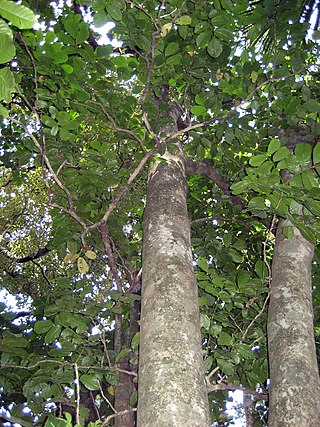
Kohekohe is a medium-sized tree in the Meliaceae family, native to New Zealand. It is found in lowland and coastal forests throughout most of the North Island and also occurs in the Marlborough Sounds in the north of the South Island. Mature trees grow up to 15 metres (49 ft) in height, with a trunk up to a metre in diameter.
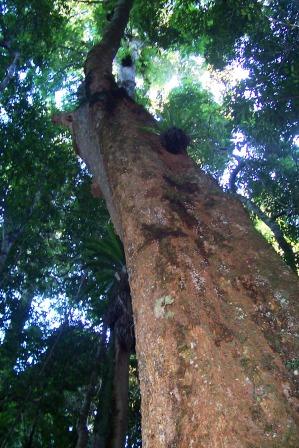
Didymocheton fraserianus, commonly known as rosewood or rose mahogany, is a medium-sized to large tree native to New South Wales and Queensland. It is widely used with the purpose of street design and to provide shade in the eastern suburbs of Sydney. Rosewood ranges from the rainforest around eastern Australia from Bundaberg in Queensland to Wyong in New South Wales. At maturity, it can reach a height of 57 metres (200 ft). It is generally known for its strong scent of rose from its bark.

Rhodosphaera is a genus of plants in the family Anacardiaceae. The genus includes a single species, Rhodosphaera rhodanthema, which is a rainforest tree of eastern Australia. It grows in sub tropical rainforests and also in the drier form of rainforests. The natural range of distribution is from the Macleay River, New South Wales to Maryborough in south east Queensland. Common names include deep yellowwood, yellow cedar and tulip satinwood.

Endiandra pubens is a rainforest tree growing in eastern Australia. The habitat is subtropical rainforest growing near streams in valleys. The range of natural distribution is from the Bellinger River, New South Wales to Bulburin National Park, south west of Gladstone, Queensland.

Arytera divaricata, known as the gap axe, coogara, coogera or rose tamarind is a forest tree of eastern Australia. An attractive plant with glossy pale and limp new leaves. It grows in fairly dry situations, often in littoral rainforests and monsoon forest.

Didymocheton muelleri, the red bean or Miva mahogany, is a rainforest tree in the family Meliaceae. It occurs in tropical, sub-tropical and littoral rainforests in eastern Australia, from the Bellinger River in New South Wales in the south, to the wet tropics of north-eastern Queensland. A signposted red bean tree may be seen near the car park of Victoria Park Nature Reserve in north-eastern New South Wales.

Elattostachys nervosa, known as the green tamarind or beetroot tree is a common rainforest tree of eastern Australia. Found in all types of rainforest, growing from Paterson, New South Wales in the south to Gympie in south east Queensland. The name Elattostachys refers to "little spikes", a flower feature of other plants in this genus. Nervosa refers to the prominent leaf venation. Beetroot Tree refers to the beetroot red leaves of the new growth.
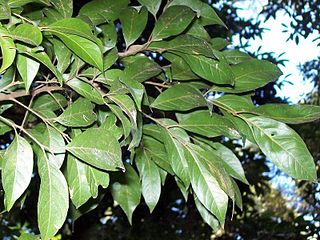
Sarcopteryx stipata, known as the steelwood, is a rainforest tree of eastern Australia occurring from the Bulga Plateau and Comboyne Plateau north west of Taree, New South Wales as far north as Fraser Island off the coast of south eastern Queensland. It grows in sub tropical rainforest but sometimes occurs in warm temperate rainforests on poorer soils. It is a member of the soap berry family. The generic name Sarcopteryx translates to "fleshy wing", as the fruit can be wing shaped. Stipata means "surrounded". The common name steelwood refers to the very tough, hard and heavy timber.

Mischocarpus pyriformis, known as the pear fruited tamarind is a rainforest tree of eastern Australia. Occurring from Seal Rocks, New South Wales to as far north as Cooktown in tropical Queensland. The sub species found in New South Wales is Mischocarpus pyriformis subsp. pyriformis.

Endiandra hayesii is an Australian rainforest tree. Despite the common name of rusty rose walnut, this tree is unrelated to northern hemisphere walnuts, and is a laurel. The former habitat is lowland sub tropical rainforest, most of which has been cleared. However some trees persist in cool sheltered gullies as far south as the Richmond River, New South Wales to just over the border at Burleigh Heads in Queensland. The rusty rose walnut is considered rare, with a ROTAP rating of 3RC-. It is named after H.C. Hayes, who collected this species at Minyon Falls.

Owenia cepiodora is a medium to large Australian tree in the family Meliaceae. It occurs in the rainforests of north eastern New South Wales and adjacent areas in Queensland. The habitat is mostly the drier Hoop Pine rainforests along the state border. Only small regrowth trees remain, as it was heavily logged in earlier times. Its status is now considered vulnerable with a ROTAP rating of 2VCi.

Arytera distylis, known as the two-leaved coogera or twin-leaved coogera is a rainforest tree of eastern Australia. It grows by streams or in sea side rainforests. It occurs from the Orara River in the Mid North Coast region of New South Wales, extending up to Maryborough in south east Queensland.
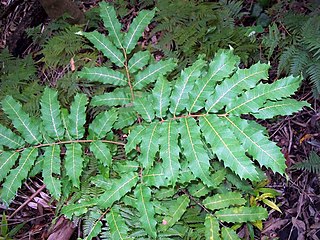
Cupaniopsis newmanii is a rainforest plant in the soapberry family. It is native to eastern Australia. The common name is long-leaved tuckeroo. A rare plant, with a ROTAP listing of 2RC-. The habitat sub tropical rainforest ranging from Mullumbimby in New South Wales to Gympie in south-eastern Queensland.
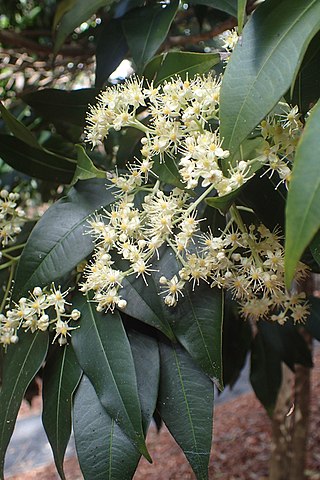
Bosistoa floydii, commonly known as the five-leaf bosistoa or five-leaved bonewood, is a species of small rainforest tree that is endemic to north-eastern New South Wales. It has pinnate leaves usually with five elliptic leaflets, and panicles of tiny, creamy white flowers.

Elattostachys xylocarpa, known as the white tamarind or short-leaf beetroot is a common rainforest tree of eastern Australia. Found in the drier rainforests, which are based on volcanic soils. From as far south as the Orara River in northern New South Wales to Bowen in tropical Queensland. The name Elattostachys refers to "little spikes", a flower feature of other plants in this genus. xylocarpa refers to the hard woody fruit.

Didymocheton pettigrewianus, commonly known as spur mahogany, spurwood, or Cairns satinwood, is a large tree in the family Meliaceae. It is native to the rainforests of Malesia, Papuasia and Queensland. In Queensland it occurs only in a small part of the northeast coast.

Goniocheton arborescens, commonly known in Australia as Mossman mahogany, is a small tree in the mahogany family Meliaceae. It is native to rainforests of Malesia, Papuasia, Queensland and nearby islands.

Epicharis parasitica, commonly known as yellow mahogany, is a species of rainforest tree in the family Meliaceae native to Taiwan, parts of Malesia, Papuasia, and northeast Queensland.

Didymocheton gaudichaudianus, commonly known as ivory mahogany, is a species of rainforest tree in the family Meliaceae, native to Malesia, Papuasia, Queensland, and some southwest Pacific islands.
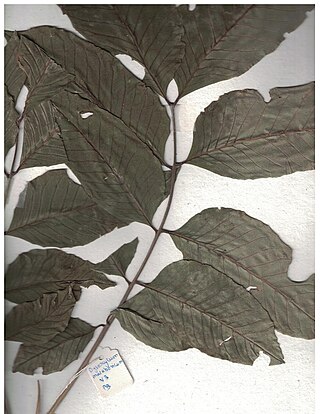
Dysoxylum malabaricum, or white cedar, is a tree species endemic to the Western Ghats, India. The species is considered Endangered under the IUCN Red List of Threatened Species.





















